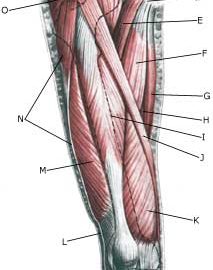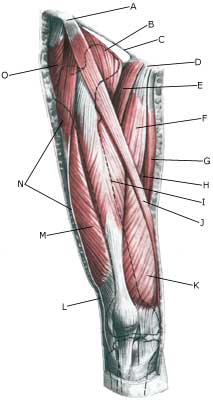|
||
|
||
| Cause: If a muscle is subjected to kicks or the like the muscle belly, which contains blood vessels, is pressed against the bones inflicting a contusion and rupture of the muscle fibres and blood vessels. The rupture usually occurs deep in the muscle. In other cases the bleeding can occur after a large or smaller muscle rupture in the anterior thigh. The bleeding can either penetrate the muscle membrane and spread over a large area, or it can accumulate in the muscle.
Symptoms: Pain and swelling in the muscle. In some cases a hard, tender accumulation can be felt (accumulated bleeding in the muscle), in other cases a bluish discoloration of the subcutis (the bleeding has penetrated the muscle membrane and spread into the sub cutis). The pain is aggravated upon activation and stretching of the muscle. Acute treatment: Click here. Examination: In slight cases with only minimal tenderness and no discomfort when walking, medical examination is not necessarily required. The severity of the tenderness is, however, not always a measure of the extent of the injury. In cases of more pronounced tenderness or pain, medical examination is required to ensure the diagnosis and treatment. Acute medical attention is necessary in cases of pronounced pain or sensory disturbance, as the bleeding can occasionally cause the pressure in the muscle compartment to increase so greatly that the blood supply and nerves can be damaged (acute compartment syndrom). The diagnosis is usually made following normal medical examination, however, if there is any doubt concerning the diagnosis, ultrasound scanning can be performed, as this is the most suitable examination to ensure the diagnosis (Ultrasonic image). The larger the bleeding as assessed by ultrasound scanning, the longer the period needed to heal the injury. Treatment: The treatment primarily consists of relief and rehabilitation as with muscle rupture in the anterior thigh. In cases of large accumulated bleeding the blood accumulation can be drained under ultrasound guidance. If the bleeding is located medial (M vastus mediale) or lateral on the thigh (M vastus lateralis), the rehabilitation will usually go more quickly. If the bleeding is located in the centre of the front thigh muscle (M vastus intermedius or M rectus femoris), a longer period of rehabilitation must be expected as sudden jumping or kicking will comprise a risk of a muscle rupture in the damaged anterior thigh muscle. Some advise caution with massage to reduce the risk of myositis ossificans (formation of bony bars within the muscle). Treatment with ultrasound has generally no convincing effect. Complications: If steady progress is not experienced, you should be medically (re)examined to ensure that the diagnosis is correct or whether complications for muscle ruptures have arisen (article). |


